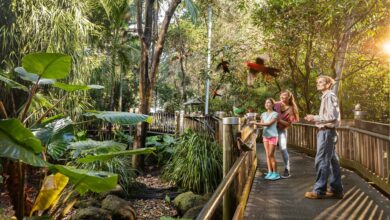
It’s been a quarter of a century since Springfield was founded and 20 years since the Queensland Parliament unanimously passed the Springfield Act.
Since then more than 37,000 people have moved into the area’s six large suburbs with the community on target to reach 130,000 by 2030.
With $15 billion invested to date and another $7 billion already announced by local and international investors, Springfield will continue to play a major role in the growth of Ipswich for many years to come.
Ipswich First takes a look at what the future holds for Greater Springfield.

Investment will drive jobs
The Queensland Premier has declared Greater Springfield to be a multi-billion dollar contributor to the state’s economy.
It was in response to the opening of the first stage of the largest master planned integrated seniors’ living campus in Australia, next to Mater Private Hospital Springfield.
A $6.4 billion flagship for Aveo, it will continue to take shape over the next 15 years and include 2,500 retirement living units.
This year, Chinese development giants RandF Properties and ETone Australia also signed a similar investment to build Australia’s largest and most unique transit oriented development adjacent Springfield Central rail station.
Subject to approvals, this major apartment development (10,000+ units) is expected to begin in 2018.
Major sporting facilities are also on the way, with the single biggest sports and recreation project in the history of Ipswich taking shape at Springfield Central off Sinnathamby Boulevard.
The sporting and recreations mecca will include eight tennis courts, 16 netball courts, eight rectangular fields, four ovals, an athletics track, three club houses and 600 car parks.
Growth expected at Greater Springfield to 2030 is tipped to generate 35,000 jobs, with the area’s growth over the past 25 years having already created about 20,000 jobs.
Health City will grow
Health has been a major pillar of Greater Springfield’s growth and is anticipated to remain an economic driver in the years ahead.
A massive 52 hectares has been set aside for the Health City precinct with stage one of Mater Private Hospital Springfield already up and running and performing both private and some public surgical procedures. Land is earmarked for future stages.
A major cancer care centre is also operating.
The Health City precinct is expected to ultimately employ around 16,000 people.
A Quest Hotel and other specialty services will open over coming months and an international design team has been appointed to assist in the comprehensive delivery of other health care providers.
Note: There are no emergency or intensive care services currently available.


Education services will expand
As the area grows, so too will the need for additional education facilities.
About 44 per cent of the Greater Springfield population is enrolled in some form of formal learning.
As another pillar of the area’s master plan, Greater Springfield already has 10 private and public schools across 10 campuses and 15 childcare centres, a major campus of the University of Southern Queensland, a TAFE and a wide variety of smaller and interesting learning institutions.
Plans for additional schools and tertiary training colleges in support of Health City and the emerging IDEA City precincts are underway.

New precinct will support innovation
In 2016, Maha Sinnathamby and Bob Sharpless, the founders and visionaries behind Greater Springfield, announced the development of an IDEAs precinct that will interconnect and support other parts of the wider project.
IDEA stands for Innovation, Design, Entrepreneurship and the Arts.
Companies such as Little Tokyo Two which provides shared workspaces and a collaborative environment for start-ups and new companies is already in place.
In the coming years, this nine hectare site will feature a number of tech organisations and host major events.
Greater Springfield is also exploring a range of energy solutions for both businesses and the home.
If words aren’t your thing, here’s a video overview:


0.5